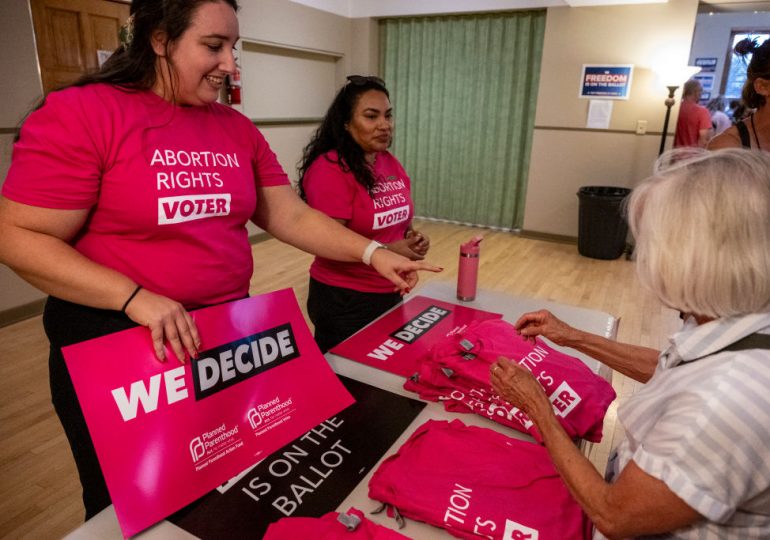Reproductive rights have taken center stage in the lead-up to the 2024 election, and 10 states have measures on the ballot that will allow voters to directly decide whether to protect abortion rights.
[time-brightcove not-tgx=”true”]
That breaks the previous record of six in 2022 for the highest number of abortion-related ballot measures in a single year, according to Ballotpedia.
Ten states from across the political spectrum—red-leaning ones like Florida, blue-leaning ones like New York, and battlegrounds like Arizona—have put the issue on the ballot this year. Many of the measures are citizen-led initiatives. Polling indicates that the majority of Americans support abortion rights—an Associated Press/NORC poll conducted in June found that roughly 61% of adults think their state should let people obtain a legal abortion for any reason. Fourteen states have banned abortion in almost all circumstances and eight others have banned it at or before 18 weeks’ gestation.
“The disconnect between what the majority of Americans want and the laws on their books in those states have sent people to ballot initiatives,” says Elisabeth Smith, director of state policy and advocacy at the Center for Reproductive Rights.
Since the U.S. Supreme Court overturned Roe v. Wade in 2022 with the Dobbs v. Jackson Women’s Health Organization ruling, seven states have put abortion on the ballot. So far, in each of those seven states (California, Kansas, Kentucky, Michigan, Montana, Vermont, and Ohio) voters have sided with abortion rights supporters.
The 10 states that will be voting on abortion this year are: Arizona, Colorado, Florida, Maryland, Missouri, Montana, Nebraska, Nevada, New York, and South Dakota. Organizers in another state, Arkansas, collected signatures to add an abortion-rights initiative to the ballot, but the state rejected the proposal—a decision that was upheld by the Arkansas supreme court in August.
Here’s what you need to know about the measures appearing on the ballot in November.
Arizona
In Arizona, voters will weigh in on citizen-led initiative Proposition 139. A “yes” vote would establish “a fundamental right to abortion under Arizona’s constitution.” It would allow abortions until a fetus could survive outside the womb—usually around the 24th week of pregnancy—but would include exceptions after that in situations where abortion is necessary to protect the life or health of the pregnant person. A “no” vote would reject this change, leaving the current state law in place.
Arizona currently prohibits abortion after 15 weeks of pregnancy, with exceptions for medical emergencies. If the ballot measure passes—which would require a simple majority—that would effectively upend the state’s current restriction.
Arizona is a key battleground state, and experts have said that having abortion on the ballot in November could have implications for the tumultuous presidential election because it’s an issue that mobilizes voters—since the fall of Roe, especially ones who support Democratic candidates.
Colorado
In May, Colorado officials confirmed that Initiative 89 would appear on the ballot in November, after organizers said they collected more than 225,000 signatures—almost twice as many as they needed to put the citizen-led initiative on the ballot.
A “yes” vote would enshrine the right to abortion in the state constitution, as well as repeal the state’s nearly four-decade-old ban on state money being used to pay for abortions. A “no” vote would reject the change. The measure needs the support of 55% of voters to pass.
Abortion is allowed at all stages of pregnancy in Colorado. If the measure passes, supporters have said it would ensure that lawmakers wouldn’t be able to undo abortion rights in the future.
Opponents had attempted to put a competing measure on the ballot that would ban abortion, but didn’t turn in enough signatures to get the initiative on the ballot.
Florida
Florida voters will weigh in on Amendment 4 in November. A “yes” vote would amend the state constitution to protect the right to abortion until fetal viability or when necessary to protect the pregnant person’s health, while a “no” vote would reject that proposed change. The measure needs the support from at least 60% of voters to pass.
Currently, abortion is banned in Florida after six weeks of pregnancy—before many people know they’re pregnant—with some exceptions for rape, incest, and when the pregnant person’s life is at risk. If the measure passes, the constitutional amendment would effectively outlaw the state’s six-week abortion ban.
While the state attorney general challenged whether the citizen-led initiative could go on the ballot, the Florida supreme court ruled in April that voters will be able to decide on the amendment in November. Supporters gathered almost a million signatures to put the measure on the ballot—exceeding the roughly 892,000 needed.
Maryland
Voters in Maryland will decide whether to enshrine the right to reproductive freedom in the state constitution via Question 1. A “yes” vote would amend the state constitution with language that would confirm the “fundamental right to reproductive freedom, including but not limited to the ability to make and effectuate decisions to prevent, continue, or end the individual’s pregnancy,” the measure states. A “no” vote would reject the change.
Maryland allows abortions up until fetal viability, and also has laws that protect people seeking or providing abortions there from restrictions or bans in other states.
Unlike most of the other states with the issue on the ballot this year, the measure in Maryland is a legislative initiative, meaning that the Democratic-controlled legislature voted to add the amendment to the ballot. The measure needs a simple majority to pass.
Missouri
The Missouri secretary of state’s office announced in August that Amendment 3 would appear on the ballot this election cycle, after abortion rights advocates turned in more than 380,000 signatures—more than double the number needed to get the initiative on the ballot.
A “yes” vote would enshrine in the state constitution the right to abortion up until fetal viability, with exceptions for later on in pregnancy in situations where the pregnant person’s life or physical or mental health is at risk. The measure also states that the government “shall not deny or infringe upon a person’s fundamental right to reproductive freedom,” which includes prenatal care, childbirth, birth control, and miscarriage care, among others. A “no” vote would reject this proposal, allowing the state’s current near-total ban on abortion to remain in place. Missouri has one of the strictest laws restricting abortion in the country.
The measure needs a simple majority to pass.
Montana
Another voter-initiated abortion measure that will appear on the ballot this November is in Montana. A “yes” vote on CI-128 would amend the state constitution “to expressly provide a right to make and carry out decisions about one’s own pregnancy, including the right to abortion,” prohibiting the government from “denying or burdening the right to abortion before fetal viability,” the measure states. A “no” vote would reject this change.
Although lawmakers have tried to restrict abortion access in the state, abortion is currently legal in Montana up until fetal viability. If the measure receives the simple majority it needs to pass, the constitutional amendment would further cement protections for abortion access, making it more difficult for lawmakers to roll back rights in the future.
Nebraska
Nebraska is the first state to have two dueling abortion amendments on the same ballot since the Dobbs decision in 2022.
One of the initiatives, which organizers called “Protect the Right to Abortion” in their petition filing, would enshrine the right to abortion until fetal viability—or later if needed to protect the health of the pregnant person—in the state constitution. The other, which backers called “Protect Women and Children” in their petition filing, would amend the state constitution to include a ban on abortion in the second and third trimesters, with exceptions for medical emergencies, rape, or incest.
Nebraska currently bans abortion after 12 weeks of pregnancy, with exceptions for rape, incest, and to save the life of the pregnant person.
Citizen-led ballot measures in Nebraska must receive a majority of the vote, and no less than 35% of the total vote, in order to pass. While it’s possible that voters could approve both of the abortion-related citizen-led initiatives, the one that gets the most “yes” votes will be enacted, according to the Nebraska secretary of state’s office.
Smith at the Center for Reproductive Rights says that creating a competing measure “is an established tactic to try to defeat a ballot initiative,” because having two measures on the ballot can cause confusion among voters.
While the Nebraska secretary of state’s office announced in August that the groups behind the rival initiatives each turned in enough signatures to appear on the ballot, the Nebraska supreme court agreed to hear arguments over a lawsuit that challenges the “Protect the Right to Abortion” measure, which could prevent voters from voting on that one in November, according to The Associated Press. The suit, filed by the conservative nonprofit law firm Thomas More Society, alleges that the abortion-rights measure violates Nebraska’s prohibition against tackling more than one topic in a single ballot measure since the initiative addresses abortion rights until viability, after viability to protect the pregnant person’s health, and whether the state should be permitted to regulate it. The court is set to hear arguments on Sept. 9.
Nevada
Nevada voters will decide whether to approve or reject the citizen-led initiative Question 6 in November. A “yes” vote would enshrine abortion rights in the state constitution, allowing abortions up until fetal viability, with exceptions after that when necessary to protect the health or life of the pregnant person. A “no” vote would reject this change.
State law already allows for abortions up to the 24th week of pregnancy, and protects people seeking or providing abortions in Nevada from restrictions in other states.
Even if the measure passes in November—and it would need a simple majority to do so—voters would need to approve it again in 2026 in order for the state constitution to be amended.
New York
New York—like Maryland—has a legislative initiative on the ballot.
Proposal 1 doesn’t explicitly mention abortion, but is a broad equal rights amendment. A “yes” vote would support amending the state constitution to declare that no person shall be discriminated against for various factors, including: “pregnancy, pregnancy outcomes, and reproductive healthcare and autonomy.” The proposed amendment mentions other factors in addition to reproductive rights, including ethnicity, sexual orientation, and gender identity. A “no” vote on the proposal would reject this change.
Abortion is currently legal in New York up to fetal viability, and supporters of the ballot measure have said that it would strengthen and cement protections for reproductive rights. “Even in states where abortion is legal and accessible, there are still people in positions of authority or power who don’t support abortion rights, so essentially, the amendment is meant to protect people across the state from someone with authority or power discriminating against them because of pregnancy, pregnancy outcomes, gender expression, gender identity, etc.,” Smith says.
The measure needs a simple majority to pass.
South Dakota
Voters in South Dakota will weigh in on the citizen-led initiative Amendment G in November. A “yes” vote on the measure would amend the state constitution to establish the right to abortion in the first trimester, allow the state to regulate abortion in the second trimester “only in ways that are reasonably related to the physical health of the pregnant woman,” and allow the state to regulate or prohibit abortion in the third trimester “except when abortion is necessary… to preserve the life or health of the pregnant woman.” A “no” vote would reject the amendment.
If the measure passes—which would require a simple majority—it would effectively upend the state’s near-total ban on abortion.
There’s a lawsuit pending against this ballot measure, but the outcome likely won’t be settled until after early voting begins.
Leave a comment








